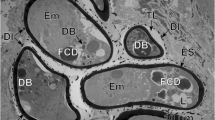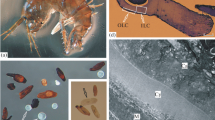Summary
The intercordal hypodermis of the pig whipworm, Trichuris suis possesses a cellular organization. Although the hypodermal cells are metabolically active they are not equipped to carry out extensive protein synthesis in the adult parasite. They are intimately associated with the overlying cuticle being separated from the latter only by a triple-layered membrane. A stable mechanical relationship appears to be maintained between cuticle and hypodermis by the presence of short hypodermal projections which are anchored in the basal layer of the cuticle. Fibres which traverse the hypodermis from the musculature to the cuticle may also contribute to this stability as well as allowing the muscles to pull on the cuticle. The inclusion of glycogen and lipid in the hypodermal cells indicates that they may also serve as storage centres.
The nerve axons are evident as a number of closed membrane-bound profiles amongst the cytoplasmic branches of the median hypodermal cord. They are unmyelinated and contain microtubules, two types of vesicles and tiny mitochondria. The possible role of these axonal inclusions in nervous transmission is discussed.
Two distinct types of myofilaments (myosin and actin) characterise the contractile, myofibrillar region of the somatic muscle cells. These are arranged longitudinally but do not show any cross-striations so that the muscle does not fit either the smooth or striated category. This morphological pattern is compared with that resolved in other nematodes.
The amyofibrillar region of the muscle takes the form of a sarcoplasmic bulb and harbours the nucleus and an abundant supply of glycogen. While it appears to play no part in muscle contraction it serves as an important depot of metabolic reserves which may be utilised during muscular activity.
Similar content being viewed by others
References
Beams, H. W., Sekhon, S. S.: Fine structure of the body wall and cells in the pseudocoelom of the nematode, Rhabditis pellio. J. Ultrastruct. Res. 18, 580–594 (1967).
Caulfield, J. B.: Effects of varying the vehicle for OsO4 in tissue fixation. J. biophys. biochem. Cytol. 3, 826–830 (1957).
Dixon, K. E., Mercer, E. H.: The fine structure of the nervous system of the cercaria of the liver fluke, Fasciola hepatica L. J. Parasit. 51, 967–976 (1965).
Fairbairn, D.: The muscle and integument lipids in female Ascaris lumbricoides. Canad. J. Biochem. 34, 39–45 (1956).
Goldschmidt, R.: Das Skelett der Muskelzelle von Ascaris nebst Bemerkungen über den Chromidialapparat der Metazoenzelle. Arch. Zellforsch. 4, 81–119 (1909).
Gray, E. G.: The fine structure of nerve. Comp. Biochem. Physiol. 36, 419–448 (1970).
Jamuar, M. P.: Electron microscope studies on the body wall of the nematode Nippostrongylus brasiliensis. J. Parasit. 52, 209–232 (1966).
Jenkins, T.: Electron microscope observations of the body wall of Trichuris suis, Schrank, 1788 (Nematoda: Trichuroidea). I. The cuticle and bacillary band. Z. Parasitenk. 32, 374–387 (1969).
— A morphological and histochemical study of Trichuris suis (Schrank, 1788) with special reference to the host-parasite relationship. Parasitology 61, 357–374 (1970).
Lee, C.-C., Miller, J. H.: Fine structure of Dirofilaria immitis body wall musculature. Exp. Parasit. 20, 334–344 (1967).
Lee, D. L.: The cuticle of adult Nippostrongylus brasiliensis. Parasitology 55, 173–181 (1965).
— An electron microscope study of the body wall of the third-stage larva of Nippostrongylus brasiliensis. Parasitology 56, 127–135 (1966).
Reger, J. F.: The fine structure of neuromuscular junctions and contact zones between body wall muscle cells of Ascaris lumbricoides (var. suum). Z. Zellforsch. 67, 196–210 (1965).
Roggen, D. R., Raski, D. J., Jones, N. O.: Further electron microscopic observations of Xiphinema index. Nematologica 13, 1–16 (1967).
Rosenbluth, J.: Ultrastructural organization of obliquely striated muscle fibres in Ascaris lumbricoides. J. Cell Biol. 25, 495–515 (1965).
Schmitt, F. O.: The molecular biology of neuronal fibrous proteins. Neurosciences Res. Progr. Bull. 6, 119–144 (1968).
Sheffield, H. G.: Electron microscopy of the bacillary band and stichosome of Trichuris muris and T. vulpis. J. Parasit. 49, 998–1009 (1963).
Smith, D. S., Gupta, B. L., Smith, U.: The organization and myofilament array of insect visceral muscles. J. Cell Sci. 1, 49–57 (1966).
Smith, K.: Electron microscopical observations on the body wall of the third-stage larva of Haemonchus placei. Parasitology 60, 411–416 (1970).
Watson, B. D.: The fine structure of the body wall in a free-living nematode, Euchromadora vulgaris. Quart. J. micr. Sci. 106, 75–81 (1965a).
— The fine structure of the body wall and growth of the cuticle in the adult nematode, Ascaris lumbricoides. Quart. J. micr. Sci. 106, 83–91 (1965b).
Wright, K. A.: The fine structure of the somatic muscle cells of the nematode, Capillaria hepatica (Bancroft, 1893). Canad. J. Zool. 42, 483–490 (1964).
— The fine structure of the cuticle and interchordal hypodermis of the parasitic nematodes, Capillaria hepatica and Trichuris myocastoris. Canad. J. Zool. 46, 173–179 (1968).
— Some neuron-hypodermis relationships in the parasitic nematode Trichuris myocastoris Enigk. J. Nematol. 2, 152–160 (1970).
Yuen, P.-H.: Electron microscopical studies of Ditylenchus dipsaci (Kühn). I. Stomatal region. Canad. J. Zool. 45, 1019–1033 (1967).
Author information
Authors and Affiliations
Rights and permissions
About this article
Cite this article
Jenkins, T. Electron microscope observations of the body wall of Trichuris suis, Schrank, 1788 (Nematoda: Trichuroidea). Z. Parasitenk. 38, 233–249 (1972). https://doi.org/10.1007/BF00329600
Received:
Issue Date:
DOI: https://doi.org/10.1007/BF00329600




